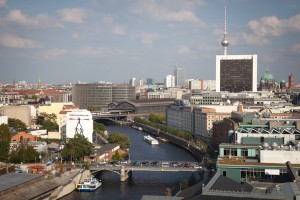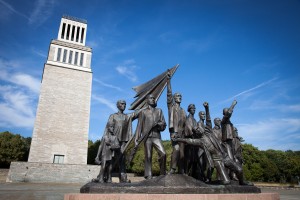 Two and a half days were hardly enough time to do Berlin justice so we had to spend our time wisely. We arrived two hours late on Monday afternoon due to train delays which cut our time even shorter. Our hotel, Hotel Pension Columbus, was ideally situated close to Zoologischer Garten subway station, just half a block from the famous Kurfürstendamm Strausse, which locally known as the Ku’Damm. This very broad, long boulevard is often referred to as the Champs-Élysées of Berlin. The tree lined street is full of shops, houses, hotels and restaurants including many fashion designers as well as several car manufacturers’ show rooms.
Two and a half days were hardly enough time to do Berlin justice so we had to spend our time wisely. We arrived two hours late on Monday afternoon due to train delays which cut our time even shorter. Our hotel, Hotel Pension Columbus, was ideally situated close to Zoologischer Garten subway station, just half a block from the famous Kurfürstendamm Strausse, which locally known as the Ku’Damm. This very broad, long boulevard is often referred to as the Champs-Élysées of Berlin. The tree lined street is full of shops, houses, hotels and restaurants including many fashion designers as well as several car manufacturers’ show rooms.
On the advice of our hotel host, we joined a historical walking tour (The Insider Tour) on Tuesday where we spent the entire day walking around the city learning about its history and culture. Our tour guide, Tarek was passionate about Berlin and enthusiastically shared his knowledge with us throughout the day.
 Inside the Reichstag Dome – great views of the city from the top.
Inside the Reichstag Dome – great views of the city from the top.
 Brandenburg Gate with Reichstag Dome in background.
Brandenburg Gate with Reichstag Dome in background.
 Brandenburg Gate – the Berlin Wall was built right in front of this monument.
Brandenburg Gate – the Berlin Wall was built right in front of this monument.
Holocaust Memorial (above and below)
 Mural on the Nazi Administration Building promoting Socialism
Mural on the Nazi Administration Building promoting Socialism
 Remnants of the wall that was installed in 1961
Remnants of the wall that was installed in 1961
dividing East from West
 Checkpoint Charley where non-Germans
Checkpoint Charley where non-Germans
passed to/from East Berlin.
 Neue Wache: Another memorial to those who perished in the war.
Neue Wache: Another memorial to those who perished in the war.
On our final day we visited Museum Island in Berlin’s historic heart, home to five world-class museums. This unique ensemble of historic buildings, all built under different Prussian kings, is a UNESCO World Heritage site. You could easily spend a week visiting these museums. We visited the Neues Museum which after years of renovation had re-opened in 2009. The museum is home to the Egyptian Museum and Papyrus Collection and the Museum of Prehistory and Early History, together with artefacts from the Collection of Classical Antiquities. Its most famous artefact is the bust of Queen Nefertite. This was a great foretaste of our upcoming visit to Egypt.
 The Ser River near Museum Island (it really is an island!)
The Ser River near Museum Island (it really is an island!)
 Some of the museums on Museum Island
Some of the museums on Museum Island
We had gorgeous weather during our three days in Berlin – warm, sunny days and cool nights. But there was a crispness to the air that reminded us that the days of summer were numbered and winter was not far off. This is the perfect time to head south! And so comes to an end our European leg of our adventure. It’s hard to believe we have been in Western Europe for almost six months, visiting a total of eight countries: Italy, France, Spain, England, Scotland, Republic of Ireland, Northern Ireland, and Germany.
On Thursday we flew to Hurghada, Egypt – yes, in spite of the recent news reports we decided to throw caution to the wind, take unnecessary risks, and put our lives in danger in order to have some good blog material to write……..just kidding! But seriously, it is a little scary when you watch the news and see all the violent demonstrations that are happening in the Middle East right now. We also know that the news is usually sensationalized and must be taken with a grain of salt. All this to say, we are heeding our own government’s advice to avoid Cairo at this moment. Instead we are travelling to the coastal, touristy area along the Red Sea south of Hurghada where we will spend nine days relaxing and diving. We’ll figure out what comes next later.
Travel Tip #1: We highly recommend Hotel Pension Columbus if you are looking for clean, comfortable, budget priced accommodations in the heart of Berlin. It is located within a 5 minute walk from the Zoologischer Garten subway station and the bus to/from the Tegel Airport is less than a block away.
Travel Tip #2: If you don’t have much time to see a city, we recommend taking a historical walking tour. Not only will you learn a lot about the history, and see a lot, the guide is usually a local from whom you will get a local spin on things. In Berlin, we recommend The Insider Tour.















